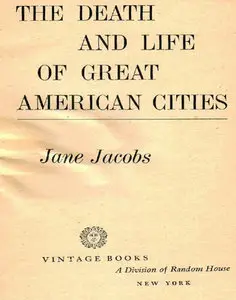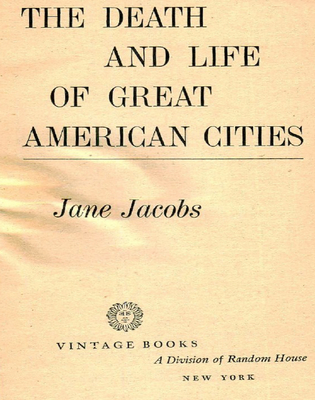"The Death and Life of Great American Cities" by Jane Jacobs
Vintage Political Science and Social Criticism. Volume 241
Vintage City | 1992/1961 | ISBN: 067974195X 9780679741954 | 473 pages | PDF | 110 MB
Vintage Political Science and Social Criticism. Volume 241
Vintage City | 1992/1961 | ISBN: 067974195X 9780679741954 | 473 pages | PDF | 110 MB
A direct and fundamentally optimistic indictment of the short-sightedness and intellectual arrogance that has characterized much of urban planning in this century, this book has, since its first publication in 1961, become the standard against which all endeavors in that field are measured. This book is an attack on current methods of city planning and re-building. It is also an explanation of new principles and an argument for different methods from those now in use.
It is the first real alternative to conventional city planning that we have had in this century. Its author, herself a city dweller and an editor of Architectural Forum, is direct and practical in her approach.
What, she asks, makes cities work?
Why are some neighborhoods full of things to do and see and why are others dull?
Why does the crime rate soar in our public housing developments and why are some of our older neighborhoods, despite their evident pov-erty, so much more safe, stable and congenial?
Why do some neighborhoods attract interested and responsible populations and why do others degenerate?
Why are Boston's North End and the eastern and western extremes of Greenwich Village good neighborhoods and why do orthodox city planners consider them slums?
What alternatives are there to current city planning and rebuilding?
Author observes that in any number of cases these very conditions - mixed uses, dense population, old buildings, small blocks, decentralized ownership - create the very opposite of slums, neighborhoods that regenerate themselves spontaneously, that are full of variety and diversity, that attract large numbers of casual visitors and responsible new residents, that encourage investment and revitalize the areas around them.
Jane Jacobs writes about what makes streets safe or unsafe; about what constitutes a neighborhood, and what function it serves within the larger organism of the city; about why some neighborhoods remain impoverished while others regenerate themselves. She writes about the salutary role of funeral parlors and tenement windows, the dangers of too much development money and too little diversity. Compassionate, bracingly indignant, and always keenly detailed, Jane Jacobs's monumental work provides an essential framework for assessing the vitality of all cities.
Contents
Acknowledgment
Illustrations
The Death and Life of Great American Cities
1 Introduction
Part One: THE PECULIAR NATURE OF CITIES
2 The uses of sidewalks: safety
3 The uses of sidewalks: contact
4 The uses of sidewalks: assimilating children
5 The uses of neighborhood parks
6 The uses of city neighbothoods
Part Two: THE CONDITIONS FOR CITY DIVERSITY
7 The generators of diversity
8 The need for primary mixed uses
9 The need for small blocks
10 The need for aged buildings
11 The need for concentration
12 Some myths about diversity
Part Three: FORCES OF DECLINE AND REGENERATION
13 The self-destruction of diversify
14 The curse of border vacuums
15 Unslumming and slumming
16 Gradual money and cataclysmic money
Part Four: DIFFERENT TACTICS
17 Subsidizing dwellings
18 Erosion of cities or attrition of automobiles
19 Visnat order: its limitations and possibilities
20 Salvaging projects
21 Governing and planning districts
22 The kind of problem a city is
Index
About Author
Vintage Political Science and Social Criticism Series
1st with TOC BookMarkLinks
This edition is set from the first American edition of 1961 and commemorates the seventy-fifth anniversary of Random Hous



